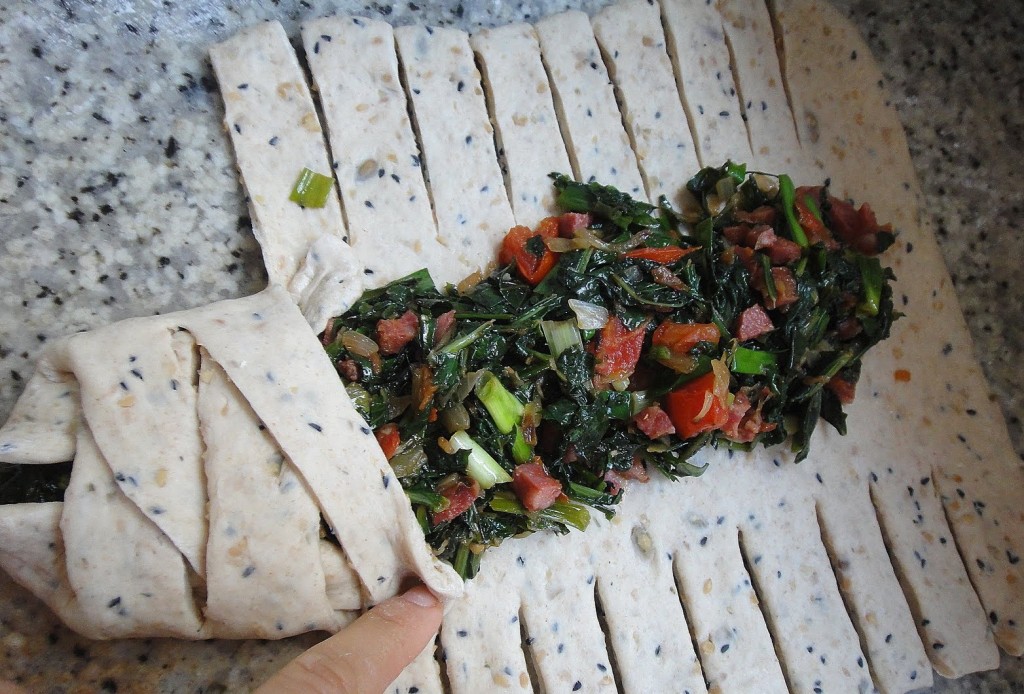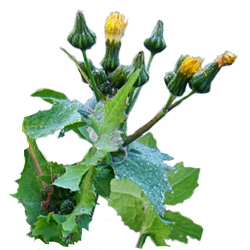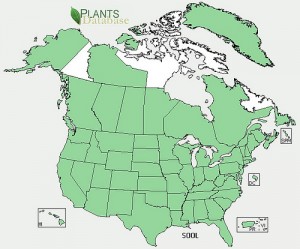Sonchus asper
Native Range: Eurasia
Invasive range: In every US State and most of Canada
Habitat: Common in disturbed sites, also found in pastures, hay fields, dunes, riparian areas, orchards, and wetlands.
Description: Leaves are lanceolate, with wavy margins, covered in spines on both the margins and beneath, and bluish-green in color. Grows yellow flowers resembling dandelions that sprout in clusters at the end of stems. Can reach up to 6 feet in height.
It is 1773. Captain Cook’s men, foraging, find a Sow Thistle at Queen Charlotte Sound in New Zealand. Which they proceed to devour along with several other “excellent vegetables,” invaders introduced from Polynesia: wild taro, two kinds of air potato, the paper mulberry, and the cabbage tree, a Cordyline. All but the last in that list go on to become invaders in North America. And the Age of Great Plant Hunters isn’t over yet.
Less bitter than dandelion, sow thistle leaves are said to be a good source of vitamins A and C, thiamine, riboflavin, niacin, calcium, phosphorus, and iron. Young leaves provide substance and depth of flavor to other greens, and in salads the yellow flowers prove a bright addition. Are you intimidated by the prickly spines on the edges of the leaves? Stir-frying will soften them. Did a nibble on a leaf make you think it’s too bitter to eat? Simmer them for ten or so minutes––cooking gets rid of the bitterness. Old leaves also go well in soup. Grated nutmeg, butter, and broth marry nicely with this weed. The roots can be roasted, ground, and used as a coffee substitute.
According to New Yorker writer Jane Kramer the local word for sow thistle in Cumbria is crespina. Be careful of the spiky center rib, writes Kramer: “I regard the small scar that I got that day as a forager’s mark of initiation.”
Even in recipes, you can trace an invader’s history. The Cambridge World History of Food, says of Maori cuisine in New Zealand, “Of the European animals, the pig–well established and running wild by the early 19th century––was the earliest and most successful introduction . . . . In fact pork and white potatoes joined native puha (sow thistle) and sweet potatoes, foods from the sea, and birds from the forest as the Maori diet in the early decades of the nineteenth century.”
Eat The Weeds: Sow Thistle
Harvest
To get the most out of harvesting sow thistle, its good to look for younger weeds, which are flavorful and best to harvest when they are about 4 to 12 inches high. Older plants can be simmered to reduce bitterness and soften the prickly spines.
Sow thistle is especially difficult to eradicate, as the white brittle roots can penetrate several feet into the soil, producing new plants from small root pieces.
Texas forager Merriwether Vorderbruggenlower picks buds before they open and places them in leftover pickle juice, letting them soak for six weeks. (We love the reuse of pickle juice!) Enjoy like capers.
Recipes
Sautéed Wild Serralha
From Weird Combinations
The author describes a simple and mouth-watering Brazilian preparation, typically served with rice and beans, fried egg, and tomato salad (see above).
1 huge bunch of sow thistle, about two pounds
5 cloves garlic, minced
5 tbsp olive oil
Kosher salt
Black pepper
Heat olive oil in a deep pan. Add garlic and sauté till fragrant and translucent. Add sow thistle, salt, and pepper. Toss. Cover pan and let it cook until volume is reduced to less than half.
Adjust flavor to your taste with more salt, pepper or olive oil.
The serralha bread shown at top is from Neide Rigo, author of the Brazilian blog Come-se. For those who speak Portuguese, an amazing culinary experience awaits. We look forward to translating and baking this; if any readers beat us to it, please let us know and we’ll publish your results.
Sow Thistle with Red Onion, Goat Cheese and Pine Nuts
From Foraging Foodie
1 bunch of sow thistle leaves (about one pound)
1 clove of garlic, minced
1/4 red onion, thinly sliced (or more if you like)
Goat cheese, crumbled
Pine nuts
Olive oil
1/4 cup chicken broth
salt and pepper
Nutmeg to taste
Rinse, chop and boil the Sow thistle leaves for a few minutes. Drain. Heat olive oil in a big fry pan and saute the red onion for three minutes. Add minced garlic and saute for another minute. Lower the heat to medium and add the Sow thistle leaves while stirring (they will shrink so you can keep adding leaves). When they’re all shrunk, add some chicken broth and cover, simmer for ten minutes. Season with salt, pepper and nutmeg. Stir in a couple of table spoons of crumbled goat cheese, or to taste, and pine nuts.
Sow Thistle Lasagna
From Celtnet
1 large onion, chopped
6 garlic cloves
1 pound canned whole tomatoes
9 lasagna pasta sheets
one pound of cooked sow thistle leave (can be sautéed as above)
1 pound ricotta cheese
1/4 pound shredded mozzarella cheese
olive oil
dried basil
dried oregano
salt
black pepper
Add oil to a pan and fry the onion until translucent, then add the garlic and as much of the dried basil and oregano as you like along with the tomatoes. Season well then bring to a simmer and mash the tomatoes. Cook for about 10 minutes.
Place a layer of lasagna sheets on the base of 9″ by 13″ pan (other sizes are fine as long as they fit the lasagna sheets). Add a layer of ricotta cheese on top, followed by a layer of tomatoes, and a layer of sow thistle greens. Repeat the process and cover the dish generously with a layer of shredded mozzarella cheese.
Cover the dish with foil and place in an oven preheated to 350° and bake for about 45 minutes. Remove the foil and return to the oven for 5 minutes to brown the top. Serve immediately.
Links
Foraging foodie has a list of simple and tasty sow thistle recipes including Buttery Sow Thistle, Stir-fried Sow Thistle and Pork, and Sautéed Sow Thistle































{ 3 comments… read them below or add one }
I recently made the leaves of sow thistle like kale chips: tossed with olive oil and seasonings, and roasted in the oven. They came out fantastic!
I can provide you with the text for the recipe if you like – to put on the sidebar there, but it’s also here:
http://foragedfoodie.blogspot.com/2016/03/Foraged-Kale-chips.html
Great site, videos, articles… this giant can’t be green enough and loves his plant life edibles! By any chance can anyone connect me with any foragers or foraging groups/classes/teachers (free) in Northern New Jersey/ Bergen County/ Hudson County even?
Thanks Green Deane! Wonderful video!